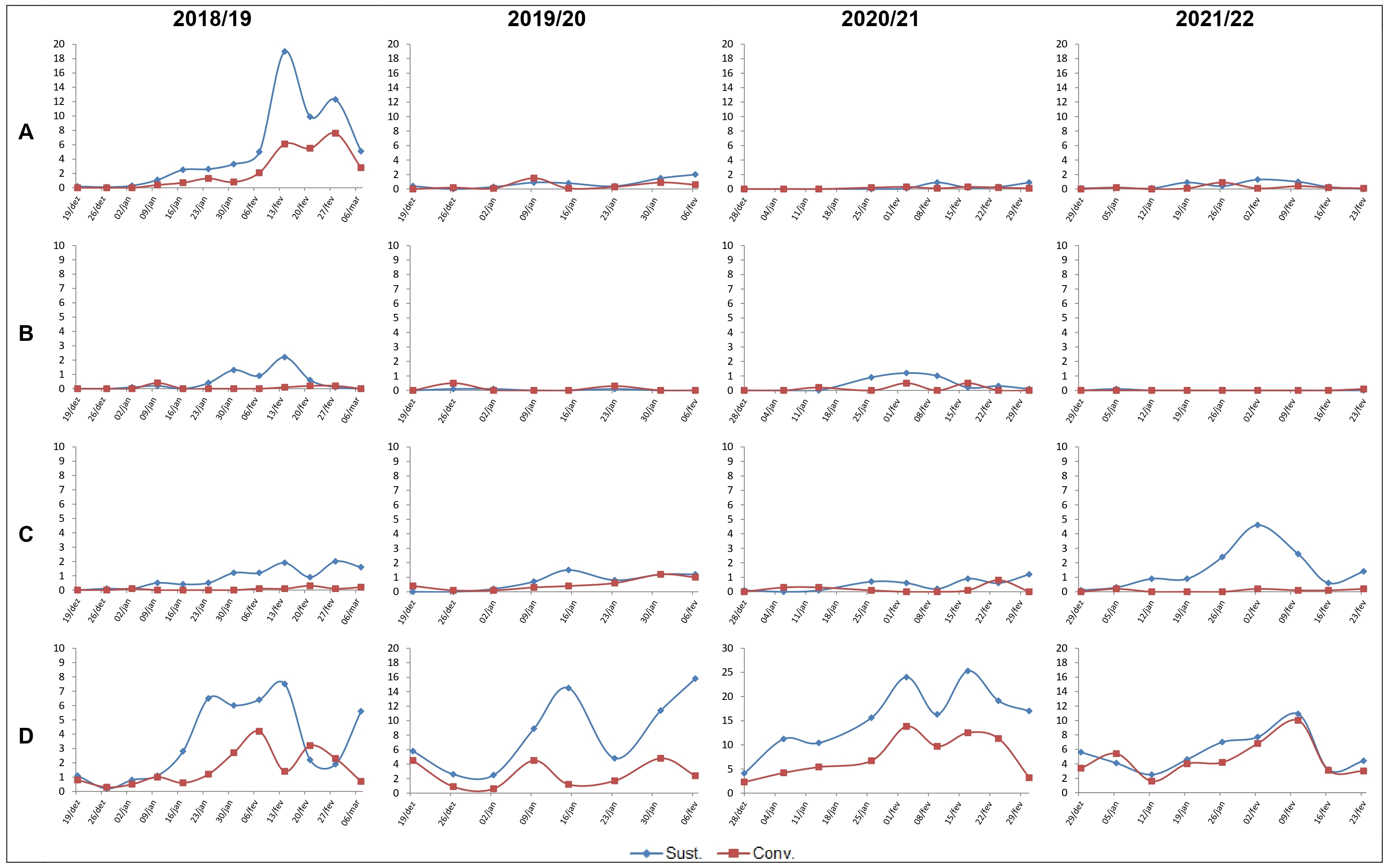Insect incidence and soybean yield under sustainable and conventional production systems in midwestern Santa Catarina
DOI:
https://doi.org/10.52945/rac.v38i2.2029Keywords:
sustainability, integrated pest management, Glycine max L.Abstract
Brazil is the world’s largest soybean producer and exporter, a promising scenario that can last by adopting sustainable production systems that meet current consumer needs. This work compared the incidence of pest insects and natural enemies, the number of insecticide sprays and grain yield in soybean areas under sustainable and conventional production systems in midwestern Santa Catarina for the agricultural years of 2018, 2019, 2020 and 2021. The sustainable system adopted integrated pest management (IPM), with insecticide spray applied when pest population reached the economic threshold. As for the conventional system, pest management was achieved with prophylactic use of insecticides (sprays every 15 days). Pest insects and natural enemies were sampled weekly in both systems using a beat cloth from V4 to pre-harvest and yield was measured at physiological maturation. Incidence of Spodoptera spp. and stinkbugs was higher in the sustainable system for the 2018/19 and 2020/21 agricultural years; however, occurrence of natural enemies was also higher in three of the four agricultural years evaluated due to an 86% reduction in insecticide spray in the referred system. Yield under the sustainable system was similar or superior to the conventional system in three of the four agricultural years evaluated, showing that sustainable production systems with IPM adoption can provide satisfactory yields combined with less environmental impact.
Metrics
Publication Facts
Reviewer profiles N/A
Author statements
- Academic society
- Epagri - Revista Agropecuária Catarinense
- Publisher
- Empresa de Pesquisa Agropecuária e Extensão Rural de Santa Catarina - Epagri
References
BORTOLOTTO, O.C.; FERNANDES, A.P.; BUENO, R.C.O.; BUENO, A.F.; KRUZ, Y. K.S.; QUEIROZ, A.P.; SANZOVO, A.; RODRIGUES, R.B. The use of soybean integrated pest management in Brazil: a review. Agronomy Science and Biotechnology, v.1, n.1, p.25-32, 2015. DOI: https://doi.org/10.33158/ASB.2015v1i1p25.
BUENO, A.F.; BATISTELA, M.J.; BUENO, R.C.F.; FRANÇA-NETO, J.B.; NISHIKAWA, M.A.N.; FILHO, A.L. Effects of integrated pest management, biological control and prophylactic use of insecticides on the management and sustainability of soybean. Crop Protection, v.30, n.7, p.937-945, 2011. DOI: https://doi.org/10.1016/j.cropro.2011.02.021.
BUENO, A.F., PANIZZI, A.R., HUNT, T.E., DOURADO, P.M., PITTA, R.M., GONÇALVES, J. Challenges for adoption of integrated pest management (IPM): the soybean example. Neotropical Entomology, v.50, p.5-20, 2021. DOI: https://doi.org/10.1007/s13744-020-00792-9
BUENO, A.D.F.; SUTIL, W.P.; JAHNKE, S.M.; CARVALHO, G.A.; CINGOLANI, M. F.; COLMENAREZ, Y.C.; CORNIANI, N. Biological control as part of the soybean Integrated Pest Management (IPM): Potential and challenges. Agronomy, v.13, n.10, 2532, 2023. DOI: https://doi.org/10.3390/agronomy13102532.
CARNEVALLI, R.A.; PRANDO, A.M.; LIMA, D.; SÁ BORGES, R.; POSSAMAI, E.J.; REIS, E.A.; GOMES, E.C.; ROGGIA, S. Resultados do manejo integrado de pragas da soja na safra 2023/2024 no Paraná. Londrina: Embrapa Soja, 2024. 51 p. (Embrapa Soja. Documentos, n. 467).
CONAB. Nova estimativa da Conab para safra de grãos 2024/25 é de 322,53 milhões de toneladas. Disponível em: https://www.conab.gov.br/ultimas-noticias/5821-nova-estimativa-da-conab-para-safra-de-graos-2024-25-e-de-322-53-milhoes-de-toneladas#:~:text=Para%20a%20soja%2C%20as%20proje%C3%A7%C3%B5es,166%2C14%20milh%C3%B5es%20de%20toneladas. Acesso em: 17 feb. 2025.
CORRÊA-FERREIRA, B.S.; PRANDO, A.M.; OLIVEIRA, A.B. de; MARX, E.; OLIVEIRA, F.T. de; CONTE, O.; ROGGIA, S. Caderneta de campo para monitoramento de insetos na soja. Londrina: Embrapa Soja, 2017.
DUFLOTH, J.H.; CORTINA, N.; VEIGA, M.; MIOR, L.C. Estudos básicos regionais de Santa Catarina. Florianópolis: Epagri, 2005. CD ROM.
EMBRAPA. Sistema Brasileiro de Classificação de Solos. 3ª ed. Rio de Janeiro: Embrapa Solos, 2013, 353p.
FATIMA, A.; JAN, S.A. Approaches for sustainable production of soybean under current climate change condition. MedCrave Online Journal of Biology and Medicine, v.8, n.1, p.27‒31, 2023. DOI: https://doi.org/10.15406/mojbm.2023.08.00179.
GIEHL, A.L.; PADRÃO, G.A.; ELIAS, H.T.; ALVES, J.R.; GUGEL, J.T.; GOULART JUNIOR, R.; MARCONDES, T. Boletim Agropecuário. Florianópolis: Epagri, 2022. 46p. (Epagri, Boletim Agropecuário 105).
MARTIN, T. N.; RUGERI, A. P.; BEUTLER, A. N.; CONCEIÇÃO, G. M.; FIPKE, G. M.; PIRES, J. L. F.; GALON, L, CUNHA, V. S. (Org). Indicações técnicas para a cultura da soja no Rio Grande do Sul e em Santa Catarina, safras 2022/2023 e 2023/2024. Santa Maria, RS, Editora GR, 2022. 136p.
NAIR, R.M.; BODDEPALLI, V.N.; YAN, M.R.; KUMAR, V.; GILL, B.; PAN, R.S.; WANG, C.; HARTMAN, G.L.; SILVA E SOUZA, R.; SOMTA, P. Global Status of Vegetable Soybean. Plants, v.12, n.3, 609, 2023. DOI: https://doi.org/10.3390/plants12030609
PANIZZI, A.R. History and Contemporary Perspectives of the Integrated Pest Management of Soybean in Brazil. Neotropical Entomology, v.42, p.119-127, 2013. DOI: https://doi.org/10.1007/s13744-013-0111-y.
POZEBON, H.; MARQUES, R.P.; PADILHA, G.; O’NEAL, M.; VALMORBIDA, I.; BEVILAQUA, J.G.; TAY, W., T.; ARNEMANN, J.A. Arthropod invasions versus soybean production in Brazil: A Review. Journal of Economic Entomology, v.113, n.4, p.1591-1608, 2020. DOI: https://doi.org/10.1093/jee/toaa108.
R CORE TEAM. R: A language and environment for statistical computing. R Foundation for Statistical Computing. Vienna, Austria, 2021. Disponível em: https://www.Rproject.org/

Downloads
Published
How to Cite
Issue
Section
License
Copyright (c) 2025 Cirio Parizotto, Rodolfo Vargas Castilhos

This work is licensed under a Creative Commons Attribution 4.0 International License.




